13 New Rules of Decluttering
Looking to get organized? O's serviceable and soulful guide can help you make a plan, follow through and get started living—with less.
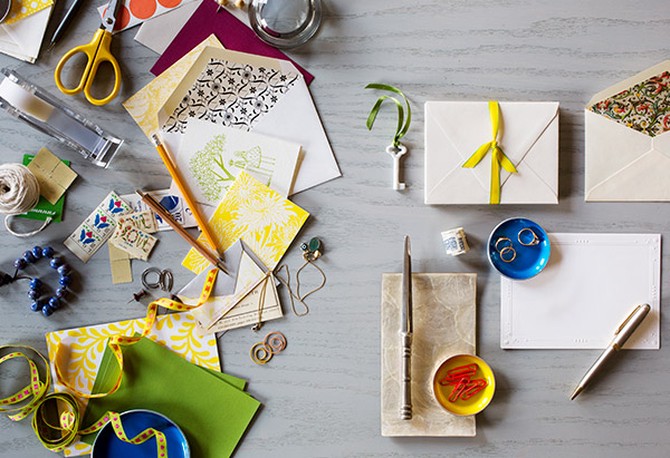
Photo: Burcu Avsar
Rule #1: Give it Away Now
The passing of two family members taught Donna Brazile that when you love something, you should let it go.
In 2012, I lost my father and my older sister Sheila within the space of a few months. If you've ever lost a family member, I don't need to describe the wrenching emotions that accompany the death of someone so close or the tears that still come unexpectedly. But one thing nobody tells you about is the stuff. As the bossiest of my parents' nine children, I had to oversee everything my dad and Sheila left behind. Months later, I was still picking through my father's military records, his guns dating to the Civil War, his 15 Bibles and Sheila's art supplies and pawnshop finds. It took every bit of inner strength I had to figure out what to do with these things that had great value for my father and sister, who now weren't around to answer my questions: "Why'd you buy that? Who do you want me to give it to?" The guitars Sheila collected, the family gumbo pot I'd borrowed and then sent back to New Orleans after Katrina wiped out my dad's kitchen, the crucifixes he carved from tree branches—you can't just throw those things away! And so my living room began to resemble a Catholic gift shop, my grief became inescapable and I sank into a mild depression.
I started thinking about my own basement and closets. I moved to Washington, D.C., at age 21 and have saved almost everything I've accumulated since: racks of clothes I can't fit into (or wouldn't want to); thousands of books (including 18 copies of Shirley Chisholm's Unbought and Unbossed); enough spatulas to host a celebrity cook-off, minus the celebrities; and a collection of vinyl, cassette tapes and eight-tracks—Diana Ross, Barbra Streisand, Nina Simone, Boz Scaggs, the Temptations—that fills an entire room of my house, because apparently when I got into music, I got into music. Then there are files from the political campaigns I've worked on: My garage is lousy with Bill Clinton and Al Gore. A year ago, when Joe Lieberman called to ask whether I had his stuff, I said, "Probably, but it's not on top."
I can imagine one of my 17 nieces and nephews walking through my door someday and having no idea where to start. My significant other is an 11-pound Pomeranian; I'm the only one who knows what in my house has real value and who will treasure it when I'm gone. So I made a decision: I'm getting rid of it now. I'm 54, in perfect health. But I never want someone else to have to go through my stuff and decide what's important. I want to be the boss while I can.
I started by digitizing my music so I could give it to the New Orleans Public Library, which lost a lot of records during Katrina. I hope some young girl from my old neighborhood will wander in, listen to Ella Fitzgerald like I did and just shut out the whole world. I'm gifting my diamond studs to my nieces on their 21st birthdays. The music that shakes my soul, the books that have kept me going, my best reserve wines: I want to share them now.
This process has been a major undertaking—and an exercise in gratitude. I've seen and experienced so many things, and I want to help others experience them, too. I'm saving memorabilia from my activist days for the new African American history museum in D.C.: a program from the 20th anniversary of the March on Washington, the signatures Rev. Jesse Jackson used to get on the presidential ballot in 1984.
My load already feels lighter. I've unearthed my dining room table and can now welcome guests into my home. The other day I dropped into Macy's and left with just two pairs of stockings. I'm too busy getting rid of things to be interested in accumulating any more.
Considering one's own mortality is a great reminder that today's all we've got. There's nothing wrong with stuff. But I want to spend less time cleaning, organizing and thinking about mine. I have too many other things still to do.
—Donna Brazile
More Clever Ways to Give it Away
My grandmother's Project 296 is named for her Ohio address. She invites one of her children per weekend to help tackle a closet or a section of the basement. (Only one—any more, she says, and they'll stay up late talking and lose focus.) With their help, she's digitized her photos and recipes and made books that tell family stories, like the reason we eat oysters on Thanksgiving. And she's assigned colored Post-it notes to each kid's family, which we can use to claim furniture we'd like to inherit. I've got my eye on the four-poster bed my mom slept in as a girl.
—Abbe Wright
In 2012, I lost my father and my older sister Sheila within the space of a few months. If you've ever lost a family member, I don't need to describe the wrenching emotions that accompany the death of someone so close or the tears that still come unexpectedly. But one thing nobody tells you about is the stuff. As the bossiest of my parents' nine children, I had to oversee everything my dad and Sheila left behind. Months later, I was still picking through my father's military records, his guns dating to the Civil War, his 15 Bibles and Sheila's art supplies and pawnshop finds. It took every bit of inner strength I had to figure out what to do with these things that had great value for my father and sister, who now weren't around to answer my questions: "Why'd you buy that? Who do you want me to give it to?" The guitars Sheila collected, the family gumbo pot I'd borrowed and then sent back to New Orleans after Katrina wiped out my dad's kitchen, the crucifixes he carved from tree branches—you can't just throw those things away! And so my living room began to resemble a Catholic gift shop, my grief became inescapable and I sank into a mild depression.
I started thinking about my own basement and closets. I moved to Washington, D.C., at age 21 and have saved almost everything I've accumulated since: racks of clothes I can't fit into (or wouldn't want to); thousands of books (including 18 copies of Shirley Chisholm's Unbought and Unbossed); enough spatulas to host a celebrity cook-off, minus the celebrities; and a collection of vinyl, cassette tapes and eight-tracks—Diana Ross, Barbra Streisand, Nina Simone, Boz Scaggs, the Temptations—that fills an entire room of my house, because apparently when I got into music, I got into music. Then there are files from the political campaigns I've worked on: My garage is lousy with Bill Clinton and Al Gore. A year ago, when Joe Lieberman called to ask whether I had his stuff, I said, "Probably, but it's not on top."
I can imagine one of my 17 nieces and nephews walking through my door someday and having no idea where to start. My significant other is an 11-pound Pomeranian; I'm the only one who knows what in my house has real value and who will treasure it when I'm gone. So I made a decision: I'm getting rid of it now. I'm 54, in perfect health. But I never want someone else to have to go through my stuff and decide what's important. I want to be the boss while I can.
I started by digitizing my music so I could give it to the New Orleans Public Library, which lost a lot of records during Katrina. I hope some young girl from my old neighborhood will wander in, listen to Ella Fitzgerald like I did and just shut out the whole world. I'm gifting my diamond studs to my nieces on their 21st birthdays. The music that shakes my soul, the books that have kept me going, my best reserve wines: I want to share them now.
This process has been a major undertaking—and an exercise in gratitude. I've seen and experienced so many things, and I want to help others experience them, too. I'm saving memorabilia from my activist days for the new African American history museum in D.C.: a program from the 20th anniversary of the March on Washington, the signatures Rev. Jesse Jackson used to get on the presidential ballot in 1984.
My load already feels lighter. I've unearthed my dining room table and can now welcome guests into my home. The other day I dropped into Macy's and left with just two pairs of stockings. I'm too busy getting rid of things to be interested in accumulating any more.
Considering one's own mortality is a great reminder that today's all we've got. There's nothing wrong with stuff. But I want to spend less time cleaning, organizing and thinking about mine. I have too many other things still to do.
—Donna Brazile
More Clever Ways to Give it Away
My grandmother's Project 296 is named for her Ohio address. She invites one of her children per weekend to help tackle a closet or a section of the basement. (Only one—any more, she says, and they'll stay up late talking and lose focus.) With their help, she's digitized her photos and recipes and made books that tell family stories, like the reason we eat oysters on Thanksgiving. And she's assigned colored Post-it notes to each kid's family, which we can use to claim furniture we'd like to inherit. I've got my eye on the four-poster bed my mom slept in as a girl.
—Abbe Wright
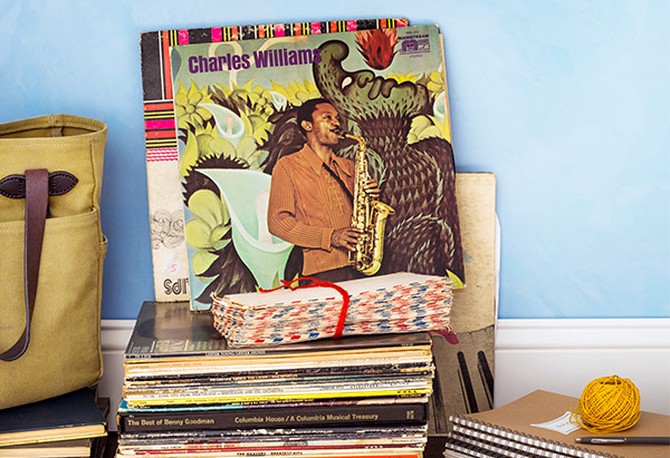
Photo: Burcu Avsar
Rule #2: But First, Know What It's Worth
In 2007, a ceramic bowl sold for $3 at a tag sale in New York state. The bowl's new owners then discovered it was a 1,000-year-old relic from China's Northern Song Dynasty; it was snapped up at auction for more than $2 million. Here's how to determine whether that gilded birdcage bequeathed to you by Uncle Sal has hidden value—before you part with it.
Google and Ebay: If an item has no identifying mark, search descriptive words (for example, "green glazed pitcher, grapes on side") to find images or websites that could provide key information. Or browse through eBay's Collectibles & Art section for similar items to determine current market value.
GoAntiques.com: If you know the name, designer, or manufacturer of your collectible—and if it's worth something—there's a good chance you'll find an identical or similar one here.
AbeBooks.com: Curious about whether your yellowing copy of To Kill a Mockingbird has any value? Type in the title, author and date of publication, and this site will search thousands of booksellers to find any offering the same or a similar edition.
—Naomi Barr
Google and Ebay: If an item has no identifying mark, search descriptive words (for example, "green glazed pitcher, grapes on side") to find images or websites that could provide key information. Or browse through eBay's Collectibles & Art section for similar items to determine current market value.
GoAntiques.com: If you know the name, designer, or manufacturer of your collectible—and if it's worth something—there's a good chance you'll find an identical or similar one here.
AbeBooks.com: Curious about whether your yellowing copy of To Kill a Mockingbird has any value? Type in the title, author and date of publication, and this site will search thousands of booksellers to find any offering the same or a similar edition.
—Naomi Barr
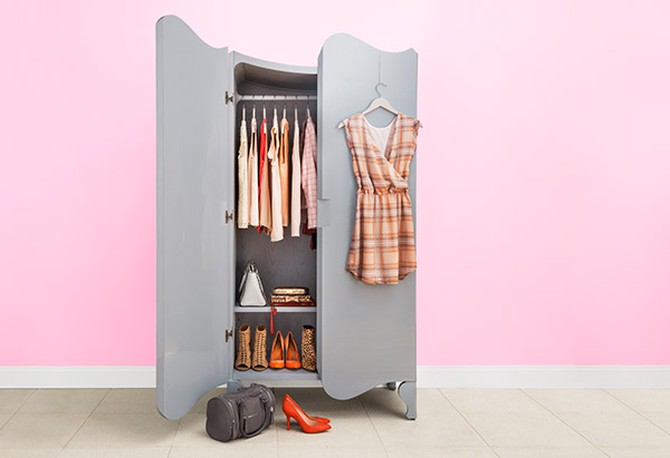
Photo: Burcu Avsar
Rule #3: You Need No More Than 33 Items in Your Closet
In 2006, Courtney Carver, then an advertising executive in Salt Lake City, was diagnosed with multiple sclerosis. After learning that stress could worsen her symptoms, she set about ridding her life of things that made her anxious, from her debt to her clutter. Carver had habitually stopped by the mall and also enjoyed shopping online. The result: a closet stuffed with items she barely wore—which made getting dressed time-consuming and overwhelming.
Carver had read that most of us wear only 20 percent of our clothes 80 percent of the time, so she decided to try making do with only 33 items—a number she chose just because it "sounded challenging." First she selected her sunglasses, purse and trenchcoat; next, a few staples that were easy to mix and match, including jeans, a black tank and a gray blazer. Carver wondered whether colleagues would notice her limited wardrobe—but she forged ahead and boxed up the rest of her clothes, planning to rotate them every three months to accommodate the changing seasons. She chronicled her efforts on a blog, Project 333, laying out parameters for those who wanted to try their own experiments: shoes, accessories (even jewelry) and outerwear count toward the 33 items; underwear and exercise clothes do not. ("But those yoga pants have to be going to yoga!" she cautions.)
Carver now says a simpler closet is the gateway to a simpler life. Not only is getting dressed a breeze, but since she sticks to well-fitting basics rather than buying trendy styles, "I get more compliments than ever before." She has donated much of her excess clothing to charity. In 2011, she quit her day job to focus on her website, BeMoreWithLess.com, which offers advice and e-courses to others hoping to pare down. Says Carver, "Not one of my happiest memories is tied to anything I own."
—Abbe Wright
Carver had read that most of us wear only 20 percent of our clothes 80 percent of the time, so she decided to try making do with only 33 items—a number she chose just because it "sounded challenging." First she selected her sunglasses, purse and trenchcoat; next, a few staples that were easy to mix and match, including jeans, a black tank and a gray blazer. Carver wondered whether colleagues would notice her limited wardrobe—but she forged ahead and boxed up the rest of her clothes, planning to rotate them every three months to accommodate the changing seasons. She chronicled her efforts on a blog, Project 333, laying out parameters for those who wanted to try their own experiments: shoes, accessories (even jewelry) and outerwear count toward the 33 items; underwear and exercise clothes do not. ("But those yoga pants have to be going to yoga!" she cautions.)
Carver now says a simpler closet is the gateway to a simpler life. Not only is getting dressed a breeze, but since she sticks to well-fitting basics rather than buying trendy styles, "I get more compliments than ever before." She has donated much of her excess clothing to charity. In 2011, she quit her day job to focus on her website, BeMoreWithLess.com, which offers advice and e-courses to others hoping to pare down. Says Carver, "Not one of my happiest memories is tied to anything I own."
—Abbe Wright
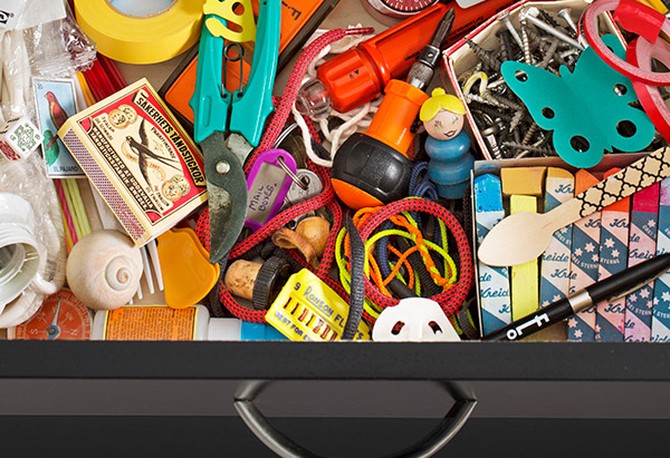
Photo: Burcu Avsar
Rule #4: You Are Allowed a Junk Drawer
Aimee Bender on the purpose—and strange beauty—of a little localized chaos.
The jagged piece of red taillight that I fished from the trunk of my first car before I sold it; the tiny burgundy wooden elephant that holds a thousand tinier paper elephants that I ordered from a toy catalog when I was 7; a bottle of facial spray from a friend that's still full; the gray rock, from an Encinitas beach, that my boyfriend gave me in college, and a few rocks from various other beaches whose significance I can't recall: My junk drawer holds uncategorizable items that only I can decipher, and even I am not sure I can decipher all of them anymore.
My grandmother had a secret drawer in her bedroom, and when we visited, she allowed us to fish in it with our eyes closed and pick a treasure for the day from among the pens, plastic animals and candy bars. One of my best finds was an empty smoky rose glass Estée Lauder moisturizer jar with a gold lid, bulby and beautiful. I held it close all day and later gave a small doll a bath in it. My junk drawer has the same aura of mystery, and though I don't fish in it, I do open it from time to time just to pick up the items inside and look at them. I like that they are both meaningful and meaningless. Even though I have to cram envelopes and other useful things tightly in the drawers that surround it, I keep my junk drawer protected.
I believe in a space that has no designated purpose and yet some reason for existence. I believe that every clean house needs a chaotic spot. I believe in places where we can go to marvel at the unknowable intricacies of our minds.
—Aimee Bender
The jagged piece of red taillight that I fished from the trunk of my first car before I sold it; the tiny burgundy wooden elephant that holds a thousand tinier paper elephants that I ordered from a toy catalog when I was 7; a bottle of facial spray from a friend that's still full; the gray rock, from an Encinitas beach, that my boyfriend gave me in college, and a few rocks from various other beaches whose significance I can't recall: My junk drawer holds uncategorizable items that only I can decipher, and even I am not sure I can decipher all of them anymore.
My grandmother had a secret drawer in her bedroom, and when we visited, she allowed us to fish in it with our eyes closed and pick a treasure for the day from among the pens, plastic animals and candy bars. One of my best finds was an empty smoky rose glass Estée Lauder moisturizer jar with a gold lid, bulby and beautiful. I held it close all day and later gave a small doll a bath in it. My junk drawer has the same aura of mystery, and though I don't fish in it, I do open it from time to time just to pick up the items inside and look at them. I like that they are both meaningful and meaningless. Even though I have to cram envelopes and other useful things tightly in the drawers that surround it, I keep my junk drawer protected.
I believe in a space that has no designated purpose and yet some reason for existence. I believe that every clean house needs a chaotic spot. I believe in places where we can go to marvel at the unknowable intricacies of our minds.
—Aimee Bender

Photo: Thinkstock
Rule #5: Don't Be Afraid to Start Over
When Karla Starr got divorced, she learned that furniture and high-thread-count sheets are not the stuff that makes a life.
Growing up, I never had much money. But while it was hard, as a kid, to appreciate hand-me-downs, my reflexive frugality eventually allowed me to survive as a freelance writer. Then I married a man who excelled in a technical profession, worked long hours and reveled in being able to buy things without consulting the price tags. Together we built a life: nice linens, a decent couch. By the time we added the ice cream maker and midcentury modern media unit, all closet space—and breathing room—had disappeared.
Before we could upsize, I left Oregon to spend two months in New York for work. My husband and I had only been married for three years, but the forced separation made us realize we were happier apart. I stayed back East, telling him to keep our stuff. When I returned for my clothes, I was greeted by a few duffel bags and boxes of books. Everything I owned fit snugly into the corner of my mom's home office, where I stashed it temporarily between her printer and aloe plant.
First, I felt panic: I'd taken a liking to sleeping on 600-thread-count sheets, and now I'd regressed to couch surfing, unable to host a proper get-together or show off my good taste in eclectic textiles. But as I contemplated the things I no longer owned, I saw them in a new light. Our high-end stove-top grill reminded me that my ex refused to try the foods I like. Our gigantic flat-screen TV, purchased to indulge a shared love of film, now signified the hours I spent distracted by the violent blasts of his video games. I hadn't noticed the weight of the disappointments I'd been living with until they were gone, until my failed marriage was no longer staring at me from a bookshelf stuffed with board games and camping gear from our doomed attempts to connect.
My ex assumed that he got the better deal because he didn't have to buy new plates. But I got a lightness both physical and psychological. I now live with two roommates, and my room is mostly empty. To see a blank slate in place of my formerly curated life is at once terrifying and thrilling.
When you have nothing, there are no small additions. A cheap dresser can't hide in a corner when it's the only furniture in the room, so I pause before allowing new things into my life. I want to own objects that comfort me or inspire me to seek adventure: maps of Morocco and Turkey, books by Joan Didion and Susan Sontag, who motivate me to write. Reminders not of who I was, but who I want to be.
Friends act as though I've barely escaped a fire, emerging from the wreckage with only the clothes on my back. I prefer to think of myself as the architect of my own life, purposefully rebuilding from the ground up.
—Karla Starr
Growing up, I never had much money. But while it was hard, as a kid, to appreciate hand-me-downs, my reflexive frugality eventually allowed me to survive as a freelance writer. Then I married a man who excelled in a technical profession, worked long hours and reveled in being able to buy things without consulting the price tags. Together we built a life: nice linens, a decent couch. By the time we added the ice cream maker and midcentury modern media unit, all closet space—and breathing room—had disappeared.
Before we could upsize, I left Oregon to spend two months in New York for work. My husband and I had only been married for three years, but the forced separation made us realize we were happier apart. I stayed back East, telling him to keep our stuff. When I returned for my clothes, I was greeted by a few duffel bags and boxes of books. Everything I owned fit snugly into the corner of my mom's home office, where I stashed it temporarily between her printer and aloe plant.
First, I felt panic: I'd taken a liking to sleeping on 600-thread-count sheets, and now I'd regressed to couch surfing, unable to host a proper get-together or show off my good taste in eclectic textiles. But as I contemplated the things I no longer owned, I saw them in a new light. Our high-end stove-top grill reminded me that my ex refused to try the foods I like. Our gigantic flat-screen TV, purchased to indulge a shared love of film, now signified the hours I spent distracted by the violent blasts of his video games. I hadn't noticed the weight of the disappointments I'd been living with until they were gone, until my failed marriage was no longer staring at me from a bookshelf stuffed with board games and camping gear from our doomed attempts to connect.
My ex assumed that he got the better deal because he didn't have to buy new plates. But I got a lightness both physical and psychological. I now live with two roommates, and my room is mostly empty. To see a blank slate in place of my formerly curated life is at once terrifying and thrilling.
When you have nothing, there are no small additions. A cheap dresser can't hide in a corner when it's the only furniture in the room, so I pause before allowing new things into my life. I want to own objects that comfort me or inspire me to seek adventure: maps of Morocco and Turkey, books by Joan Didion and Susan Sontag, who motivate me to write. Reminders not of who I was, but who I want to be.
Friends act as though I've barely escaped a fire, emerging from the wreckage with only the clothes on my back. I prefer to think of myself as the architect of my own life, purposefully rebuilding from the ground up.
—Karla Starr
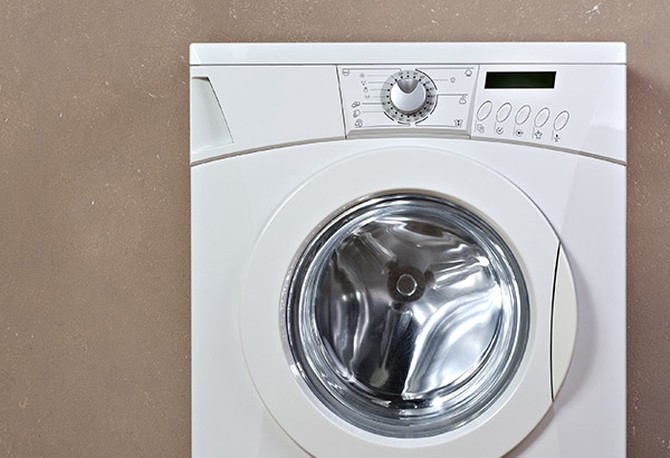
Photo: Thinkstock
Rule #6: Finish the Cycle (A Peter Walsh Theory)
Consider your washing machine: You'd never fill it with dirty clothes, let it run for 20 minutes, then turn it off and let the clothes sit for two days. That would create a stinky mess! So it is with our daily routines: Doing things halfway wreaks havoc. That's why it's important to finish each cycle. For example, if you bring a dirty plate into the kitchen, don't leave it on the counter—put it in the dishwasher! When you pull on sweatpants after work, don't toss your skirt onto the bed—hang it in your closet. If you bring in the mail, don't drop it on the table—sort it (recycle any junk; leave bills in a flat tray). Each of these tasks requires about a minute, which is minimal compared with the time you'd waste later looking for that skirt or bill.
—Peter Walsh
—Peter Walsh
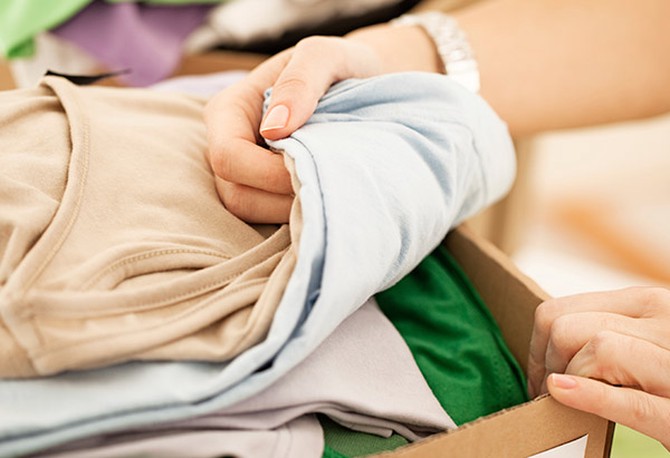
Photo: Thinkstock
Rule #7: Throw a Junk Swap Party
Jenny Gottstein, cofounder of Score!, which hosts massive public swaps on both coasts ("Redistribute. Reuse. Reinvent."), explains how you can gather your friends and trade a few things you don't want for some you do.
1. Invite guests at least a month in advance. This will give them time to unearth the treasures lurking in their closets and cabinets.
2. Ask everyone to bring clean, working items that just don't fit into their lives, like a never-used breadmaker or an extra yoga mat. You could also request that items fit a theme—say, Kitchen Confidential.
3. Display everyone's items on tables. Then take turns claiming one item at a time. After three rounds, turn it into a free-for-all.
4. Ask a couple of friends to help you box up anything remaining for Goodwill. Wine is usually a sufficient bribe.
—Abbe Wright
1. Invite guests at least a month in advance. This will give them time to unearth the treasures lurking in their closets and cabinets.
2. Ask everyone to bring clean, working items that just don't fit into their lives, like a never-used breadmaker or an extra yoga mat. You could also request that items fit a theme—say, Kitchen Confidential.
3. Display everyone's items on tables. Then take turns claiming one item at a time. After three rounds, turn it into a free-for-all.
4. Ask a couple of friends to help you box up anything remaining for Goodwill. Wine is usually a sufficient bribe.
—Abbe Wright

Illustration: Joe McKendry
Rule #8: If You're Stalling Out, Try Repeating a Declutter Mantra
A few of our favorite Peter Walsh–isms...
"That ugly sweater your mother gave you is not your mother."
"You only have the space you have."
"Flat surfaces are not storage areas."
"When you put things into a pile to deal with 'later,' you have lost the battle."
"Everything in your home should reflect your vision for the life you want."
"That ugly sweater your mother gave you is not your mother."
"You only have the space you have."
"Flat surfaces are not storage areas."
"When you put things into a pile to deal with 'later,' you have lost the battle."
"Everything in your home should reflect your vision for the life you want."

Photo: Thinkstock
Rule #9: It is 2014. Get Your Digital House in Order.
Clutter on your computer, smartphone, or tablet is almost as distracting as a mess in your living room. With these services, you can tidy all your devices right up.
Desktop
Never again will your cute kitten-themed desktop wallpaper be hidden by unsightly icons. With Fences for Windows ($10; StarDock.com) or Desktop Groups for Mac ($10; KiteStack.com), you can sort icons into organized clusters on your desktop, which can be visible or hidden, so they're easy to find and easier on the eyes.
Photos
The photo management software Picasa (free; Picasa.Google.com) will scan your hard drive for pictures and help you sort them into albums by date, by place, or even by face. (It also syncs with Google+ for hassle-free sharing and other nifty features, including one that uses algorithms to identify the best shots.)
Passwords
Keep track of your gazillion usernames and passwords with LastPass (free; LastPass.com), which securely stores log-in info for an unlimited number of websites. Install the program in your web browser, set up a master password and LastPass will remember the sign-in details for your favorite sites.
—Rachel Swaby
Desktop
Never again will your cute kitten-themed desktop wallpaper be hidden by unsightly icons. With Fences for Windows ($10; StarDock.com) or Desktop Groups for Mac ($10; KiteStack.com), you can sort icons into organized clusters on your desktop, which can be visible or hidden, so they're easy to find and easier on the eyes.
Photos
The photo management software Picasa (free; Picasa.Google.com) will scan your hard drive for pictures and help you sort them into albums by date, by place, or even by face. (It also syncs with Google+ for hassle-free sharing and other nifty features, including one that uses algorithms to identify the best shots.)
Passwords
Keep track of your gazillion usernames and passwords with LastPass (free; LastPass.com), which securely stores log-in info for an unlimited number of websites. Install the program in your web browser, set up a master password and LastPass will remember the sign-in details for your favorite sites.
—Rachel Swaby
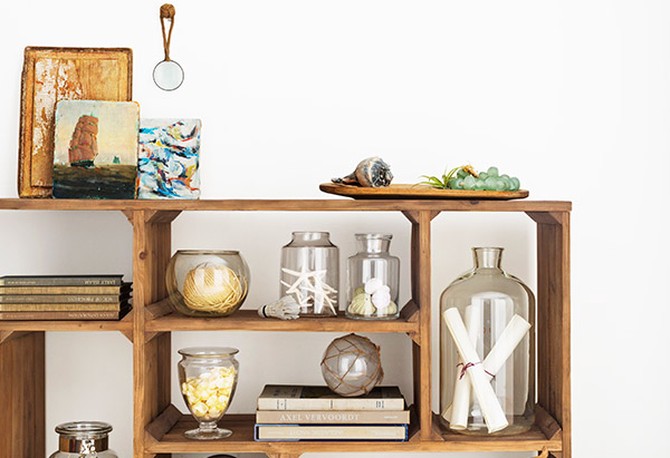
Photo: Burcu Avsar
Rule #10: Fork It
"Everyone has a place in their house for forks. If you found a random fork in the bathroom or under the couch, you'd immediately know it didn't belong there and would return it to its drawer without another thought. Everything in your life should be this easy to put away. If an item occupies no specific location when not in use, it becomes clutter."
—Productivity consultant Steve McClatchy, author of the new book Decide: Work Smarter, Reduce Your Stress, and Lead By Example, who developed a more organized approach to life after growing up in a home with 11 siblings
—Productivity consultant Steve McClatchy, author of the new book Decide: Work Smarter, Reduce Your Stress, and Lead By Example, who developed a more organized approach to life after growing up in a home with 11 siblings
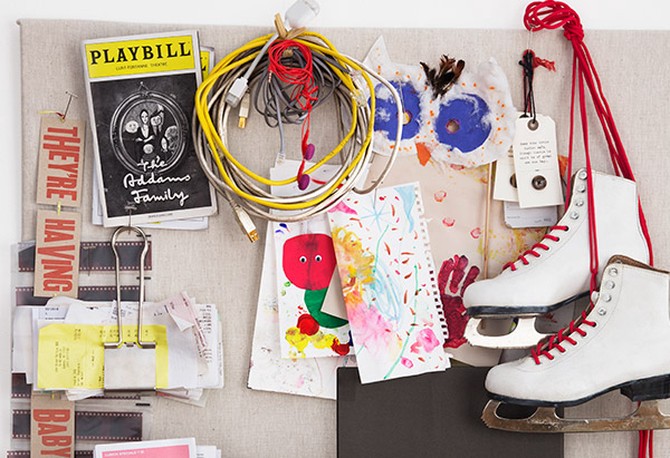
Photo: Burcu Avsar
Rule #11: You Have Permission to Get Rid of...
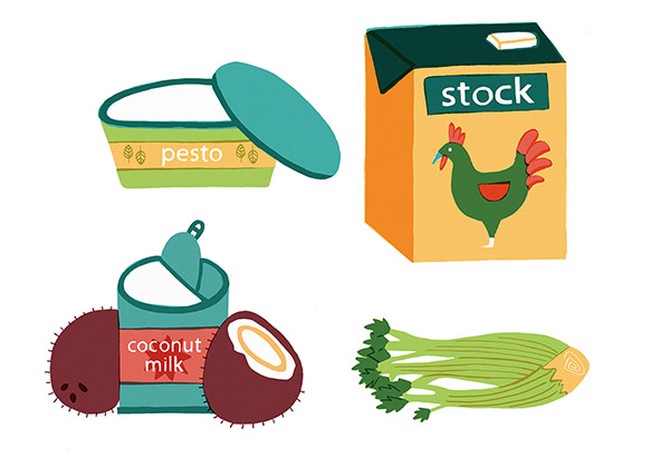
Illustration: Esme Lonsdale
Rule #12: Use What You Have
Is your fridge crowded with the remnants of recipes past? Here, a few creative solutions for some common leftover ingredients.
Chicken Stock
Glazed Carrots: In a large skillet, heat 1 tsp. oil over medium heat. Add 1/2 pound carrots, quartered, and cook until golden, 5 to 7 minutes. Add 1 cup chicken stock and cook, covered, 3 minutes. Stir in 3 Tbsp. orange juice (or 3 Tbsp. lemon juice plus 1 Tbsp. maple syrup or honey) and reduce stock to a glaze, 2 to 3 minutes. Garnish with pecans or fresh parsley.
Celery
Creamy Potato Soup: In a large pot, cover 1/2 bunch chopped celery, 1 large diced potato, 1 chopped onion and 2 peeled garlic cloves with 3 cups water. Simmer 15 to 20 minutes, then transfer to a blender with 1/2 cup low-fat Greek yogurt and 1 tsp. dried tarragon; puree until smooth. Season to taste with salt and pepper.
Coconut Milk
Coconut Pudding: In a saucepan over low heat, whisk 1/4 cup sugar, 2 Tbsp. cornstarch and 1/4 tsp. salt. Whisk in 1 cup each unsweetened coconut milk and milk and bring to a gentle boil, stirring until texture resembles heavy cream, 1 minute. Remove from heat and stir in 1/4 tsp. vanilla extract or a spoonful of peanut butter. Chill and top with sliced fresh mango.
Pesto Sauce
Breaded Chicken: In a shallow dish, mix 1/2 cup pesto with 2 Tbsp. each Dijon mustard and mayonnaise. Coat boneless, skinless chicken breasts with the mixture, then cover with bread crumbs. Bake until cooked through, 15 to 20 minutes.
Recipes by Melissa d'Arabian, host of the Food Network's Ten Dollar Dinners.
Chicken Stock
Glazed Carrots: In a large skillet, heat 1 tsp. oil over medium heat. Add 1/2 pound carrots, quartered, and cook until golden, 5 to 7 minutes. Add 1 cup chicken stock and cook, covered, 3 minutes. Stir in 3 Tbsp. orange juice (or 3 Tbsp. lemon juice plus 1 Tbsp. maple syrup or honey) and reduce stock to a glaze, 2 to 3 minutes. Garnish with pecans or fresh parsley.
Celery
Creamy Potato Soup: In a large pot, cover 1/2 bunch chopped celery, 1 large diced potato, 1 chopped onion and 2 peeled garlic cloves with 3 cups water. Simmer 15 to 20 minutes, then transfer to a blender with 1/2 cup low-fat Greek yogurt and 1 tsp. dried tarragon; puree until smooth. Season to taste with salt and pepper.
Coconut Milk
Coconut Pudding: In a saucepan over low heat, whisk 1/4 cup sugar, 2 Tbsp. cornstarch and 1/4 tsp. salt. Whisk in 1 cup each unsweetened coconut milk and milk and bring to a gentle boil, stirring until texture resembles heavy cream, 1 minute. Remove from heat and stir in 1/4 tsp. vanilla extract or a spoonful of peanut butter. Chill and top with sliced fresh mango.
Pesto Sauce
Breaded Chicken: In a shallow dish, mix 1/2 cup pesto with 2 Tbsp. each Dijon mustard and mayonnaise. Coat boneless, skinless chicken breasts with the mixture, then cover with bread crumbs. Bake until cooked through, 15 to 20 minutes.
Recipes by Melissa d'Arabian, host of the Food Network's Ten Dollar Dinners.
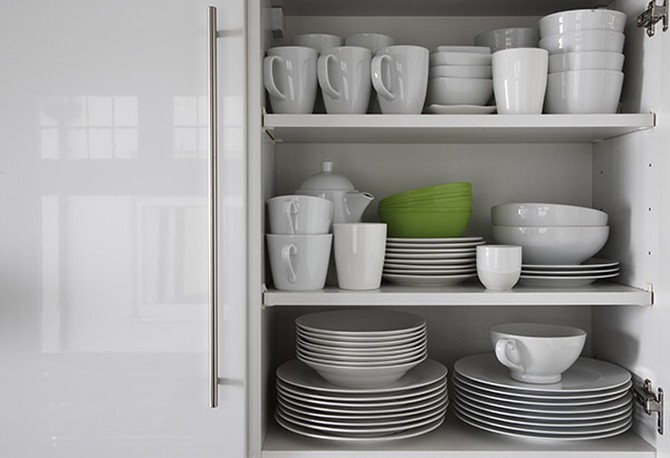
Photo: Thinkstock
Rule #13: Life Will Always Be Messy. That's a Good Thing.
Psychiatrist Melva Green, MD, coauthor of Breathing Room: Open Your Heart by Decluttering Your Home, reveals the truth about the piles of stuff that just keep coming back. (Hint: They can set you free.)
To clutter is human. We collect stories, experiences and memories—why not things? It's natural to accumulate, and to believe otherwise is a setup for disappointment and failure.
Almost everything we hold on to—even down to our junk mail and extra pens—symbolizes what's happening in our lives on an emotional and psychological level. Since we are constantly evolving, it makes sense that our possessions are, too. Think about the items you loved years ago that no longer speak to who you are. Maybe you have tons of expensive dishes because you used to love to host big dinner parties—but these days you appreciate a quiet evening with just you and the dog. You don't need those dozen place settings anymore, and that's as it should be. Just because something made you happy in the past doesn't mean that you have to keep it forever.
When your clutter comes back (and it will), you might be tempted to criticize yourself. Instead, try to remember that de-cluttering is a chance to open up physical and mental space, creating room for possibility. It's something that should happen periodically, because your closets and shelves contain so much more than stuff. They may hold love, joy and comfort—say, your grandmother's linens. But they also may harbor items that bring you guilt or regret—like the trinket your ex gave you—and it's time to let those things go. As you clean, you can and should be mindful of every item you give up and what it once did for you. Engage with your things. And as your pile grows, dig in and appreciate it. It means you're growing, too.
—Melva Green, MD
Next: 16 declutter projects for a saner you
To clutter is human. We collect stories, experiences and memories—why not things? It's natural to accumulate, and to believe otherwise is a setup for disappointment and failure.
Almost everything we hold on to—even down to our junk mail and extra pens—symbolizes what's happening in our lives on an emotional and psychological level. Since we are constantly evolving, it makes sense that our possessions are, too. Think about the items you loved years ago that no longer speak to who you are. Maybe you have tons of expensive dishes because you used to love to host big dinner parties—but these days you appreciate a quiet evening with just you and the dog. You don't need those dozen place settings anymore, and that's as it should be. Just because something made you happy in the past doesn't mean that you have to keep it forever.
When your clutter comes back (and it will), you might be tempted to criticize yourself. Instead, try to remember that de-cluttering is a chance to open up physical and mental space, creating room for possibility. It's something that should happen periodically, because your closets and shelves contain so much more than stuff. They may hold love, joy and comfort—say, your grandmother's linens. But they also may harbor items that bring you guilt or regret—like the trinket your ex gave you—and it's time to let those things go. As you clean, you can and should be mindful of every item you give up and what it once did for you. Engage with your things. And as your pile grows, dig in and appreciate it. It means you're growing, too.
—Melva Green, MD
Next: 16 declutter projects for a saner you
From the March 2014 issue of O, The Oprah Magazine

